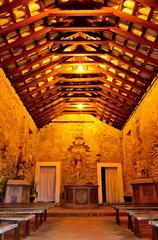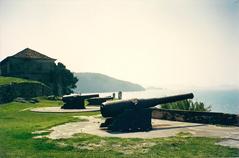Fortaleza de São José da Ponta Grossa and Fortaleza de São José da Barra do Sul: Visiting Hours, Tickets, and Historical Sites in Florianópolis
Date: 04/07/2025
Introduction
Florianópolis, the vibrant capital of Santa Catarina Island in southern Brazil, is home to some of the country’s most significant colonial fortifications. Among the most notable are the Fortaleza de São José da Ponta Grossa and Fortaleza de São José da Barra do Sul—two sites that not only offer stunning vistas and immersive architecture but also serve as living monuments to the region’s indigenous heritage and Portuguese colonial history. This guide provides detailed information on visiting hours, ticketing, historical context, site features, accessibility, and travel tips, enriching your journey into Florianópolis’ multi-layered past.
For further background, see resources like Wikipedia: Florianópolis, Visite Floripa, and Brazil Brasil.
Table of Contents
- Historical Overview
- Architectural and Cultural Heritage
- Visitor Information
- Visitor Experience and Travel Tips
- Preservation and Education
- Frequently Asked Questions (FAQ)
- Conclusion and Resources
Historical Overview
Indigenous Roots and Early Settlement
Before European colonization, Santa Catarina Island and its surroundings were inhabited by the Carijós, a subgroup of the Tupi-Guarani people, who called the region “Meiembipe” (“mountain along the channel”). Archaeological evidence, such as sambaquis (shell mounds) and pottery, attests to their presence for over four millennia (Brazil Brasil). The Carijós were skilled navigators and fishermen, and their influence remains a vital part of local culture today.
Portuguese explorers arrived in the early 16th century, with the island’s strategic value quickly recognized for controlling trade and navigation routes between the Rio de la Plata basin and the Brazilian coast. The settlement was first known as Ilha dos Patos (1514) and later renamed Ilha de Santa Catarina.
Colonial Fortification and Regional Defense
The 18th century saw increasing tensions between Portugal and Spain over control of southern Brazil. In response, the Portuguese constructed a network of defensive forts to protect Santa Catarina Island from foreign incursions and piracy. The Fortaleza de São José da Ponta Grossa (northern entrance) and Fortaleza de São José da Barra do Sul (southern entrance) were key elements of this system, working in tandem with other forts like Fortaleza de Santa Cruz de Anhatomirim and Fortaleza de Santo Antônio de Ratones to create overlapping fields of fire and secure maritime access (Wikipedia: Coastal defence and fortification).
These fortresses played important roles in regional conflicts and trade, serving as bases for local militias and customs checkpoints, and helping to foster settlement and economic growth in what is now Florianópolis (facts.net).
Architectural and Cultural Heritage
Distinctive Features of Fortaleza de São José da Ponta Grossa
Constructed in 1740 under Brigadeiro José da Silva Paes, Fortaleza de São José da Ponta Grossa is a prime example of Portuguese Renaissance military architecture (santacatarinacomcriancas.com.br). Its layout follows classic defensive design: thick stone walls, angular bastions, and terraced levels adapted to the local topography. Key structures include:
- Commander’s House (Casa do Comandante): A two-story brick building now used for exhibitions.
- Powder Magazine (Paiol da Pólvora): Secure munitions storage, currently housing multimedia displays.
- Chapel of Saint Joseph (Capela de São José): A simple, bell-tower-less chapel, restored and still in use.
- Artillery Batteries: Once equipped with over 30 cannons, covering both sea and land approaches.
After brief Spanish occupation in 1777 and subsequent restoration to Portuguese control, the fort gradually lost military importance, eventually being preserved as a national heritage site in 1938 (pointer.com.br).
Exploring Fortaleza de São José da Barra do Sul
Located at the southern tip of the island, this fort is similarly designed with robust stone structures, passageways, and lookouts providing panoramic views of the bay (The Tourist Checklist). Visitors can explore:
- Stone corridors and rooms used by colonial soldiers.
- Authentic cannons and artillery emplacements.
- Elevated lookout towers and a central courtyard.
The fort’s well-preserved state offers visitors a direct connection to Brazil’s colonial defensive strategies and the daily life of 18th-century garrisons (I Heart Brazil).
Visitor Information
Visiting Hours and Tickets
Both forts generally operate on the following schedule:
- Opening Days: Tuesday to Sunday (closed Mondays)
- Hours: 9:00 AM to 5:00 PM
- Admission: R$10–R$20 for adults, with discounts for students, seniors, and children (children under 6 or 7 often free). Some days, such as heritage weeks, may offer free entry (Visite Floripa).
Tickets are sold at the entrance; advance booking is recommended during peak tourist periods.
Guided Tours and Events
Guided tours are offered daily, typically at set times (e.g., 10:00 AM and 3:00 PM), and provide rich insights into the forts’ history, architecture, and the broader colonial context. Tours are mainly in Portuguese, but English- or Spanish-speaking guides may be available if arranged in advance (The Tourist Checklist). Special events, including historical reenactments and festivals, are held periodically.
Accessibility and Facilities
Both sites are historic and present some challenges for visitors with limited mobility:
- Uneven stone pathways and steps; limited wheelchair access.
- Accessible restrooms and some level pathways are available at Fortaleza de São José da Ponta Grossa.
- Assistance can be requested in advance; comfortable shoes are highly recommended.
Facilities include restrooms, a visitor center or kiosk, and sometimes small snack vendors. There are no on-site restaurants, but picnic areas are available.
Visitor Experience and Travel Tips
Photography and Views
Both forts offer spectacular panoramic views of the strait, bay, and surrounding coastline. Early morning and late afternoon are ideal for photography, with softer light and fewer crowds. The elevated positions of the forts provide excellent vantage points for landscape and architectural shots.
Nearby Attractions
- Praia do Forte Beach: Adjacent to Fortaleza de São José da Ponta Grossa, perfect for relaxing after your visit.
- Historic Downtown Florianópolis: Explore colonial-era landmarks such as the Metropolitan Cathedral and Public Market.
- Other Forts: Fortaleza de Santa Cruz de Anhatomirim and Fortaleza de Santo Antônio de Ratones are accessible by boat or car, offering additional historical context.
Safety and Practical Advice
- Weather: Bring sunscreen, water, and a hat. Surfaces can be slippery when wet.
- Language: Most staff speak Portuguese; consider booking a bilingual guide or using a translation app.
- Respect: These are national heritage sites—avoid climbing on structures not meant for access, and help preserve the site for future generations.
- Tickets and Crowds: Arrive early, especially on weekends or during festivals, for a more peaceful visit.
Preservation and Education
The forts’ preservation results from collaborations between government, universities, and community organizations. Ongoing restoration, educational programs, and cultural events ensure these sites remain vibrant parts of Florianópolis’ identity. Informational materials and temporary exhibitions help interpret the forts’ historical significance for visitors of all ages.
Frequently Asked Questions (FAQ)
Q: What are the visiting hours for the forts?
A: Both forts are open Tuesday to Sunday, 9:00 AM to 5:00 PM. Closed on Mondays.
Q: How much do tickets cost?
A: Admission is R$10–R$20 for adults, with discounts for students, seniors, and children. Some days offer free admission.
Q: Are guided tours available in English?
A: Most tours are in Portuguese, but English- or Spanish-speaking guides may be available if booked in advance.
Q: Are the forts accessible for visitors with mobility issues?
A: Accessibility is limited due to historic terrain; some areas have ramps and accessible restrooms. Contact the visitor center before your visit.
Q: Can I take photographs?
A: Yes, photography is encouraged throughout both sites.
Conclusion and Resources
The Fortaleza de São José da Ponta Grossa and Fortaleza de São José da Barra do Sul are essential destinations for anyone seeking to understand Florianópolis’ rich indigenous and colonial legacy. Their strategic locations, impressive architecture, and engaging exhibits make them must-visit sites for history enthusiasts, families, and travelers alike. Plan your visit with the latest information on hours and tickets, and consider combining your trip with nearby beaches and cultural attractions for a truly memorable experience.
For up-to-date details, visit Visite Floripa, Wikipedia: Coastal defence and fortification, and Brazil Brasil.
Download the Audiala app for curated tours, maps, and exclusive content, and follow us on social media for the latest updates on events and travel tips.
References and Further Reading
- Wikipedia: Florianópolis
- facts.net: 39 Facts About Florianópolis
- pointer.com.br: Forte de São José da Ponta Grossa
- Brazil Brasil: Florianópolis History
- The Tourist Checklist: Things to Do in Florianópolis
- Visite Floripa: Fortaleza de São José da Ponta Grossa
- Wikipedia: Coastal defence and fortification
- santacatarinacomcriancas.com.br: Fortaleza de São José da Ponta Grossa
- I Heart Brazil: Things to Do in Florianópolis
- My Global Viewpoint: Things to Do in Florianópolis






